Trees Birds Mammals Fish Amphibians Reptiles
Wild Algarve
Bookshop
Geastrum striatum (DC.) - Striate Earthstar
Phylum: Basidiomycota - Class: Agaricomycetes - Order: Geastrales - Family: Geastraceae
Distribution - Taxonomic History - Etymology - Identification - Culinary Notes - Reference Sources
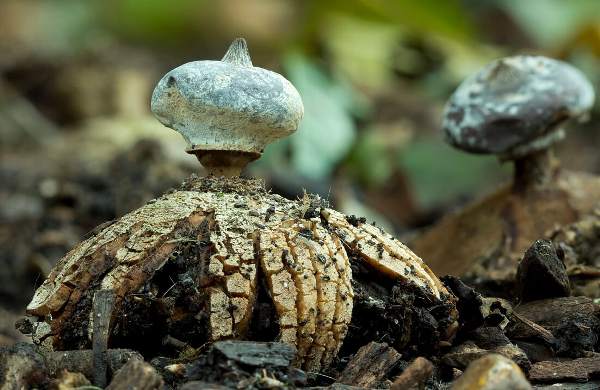
The Striate (or Striated, as some call it) Earthstar is an uncommon find, and it is very easy to miss because it blends in so well with fallen leaves and other dead vegetation under trees, which is where this earthstar generally occurs.
Distribution
From mid summer through to winter and often into the following spring the Striate Earthstar can be seen in Britain and Ireland as well as in many parts of northern and central mainland Europe including Sweden and France.
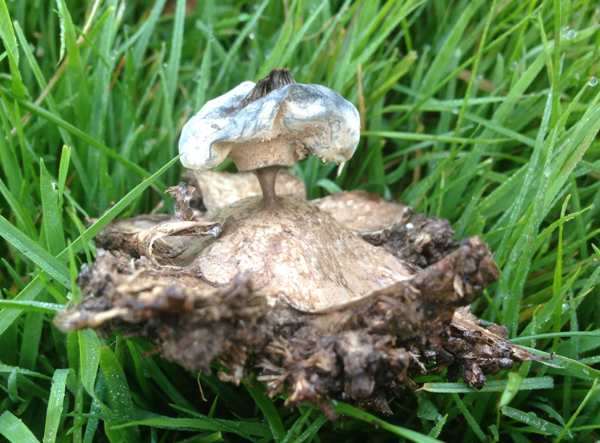
Taxonomic history
The basionym of this species dates from 1801, when the Striated Earthstar was described scientifically by Augustin Pyramis De Candolle and given the binomial scientific name Geastrum striatum by which it is generally known today.
Synonyms of Geastrum striatum include Geastrum bryantii Berk., Geastrum calyculatum Fuckel, Geastrum kunzei G. Winter and Geastrum pectinatum var. calyculatum (Fuckel) Quél.
Etymology
Geastrum, the generic name, comes from Geo- meaning earth, and -astrum meaning a star. Earthstar it is, then. The specific epithet striatum means 'striped or ribbed' (striated) and is a reference to the striations around the beak-like pore.
Identification guide
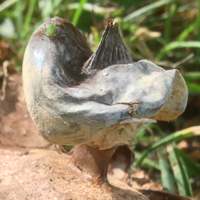 |
Spore sac
The pale greyish-blue to greyish-buff spore sac (often referred to as the bulb) is 1 to 2cm across and subglobose (in the form of a vertically compressed sphere) with a long, striated beak terminating in a small round pore via which spores emerge. There is a basal colar (evident in the main picture, see above), below which is a short stem connecting to the rayed base (the rays being formed when the outer peridium splits). |
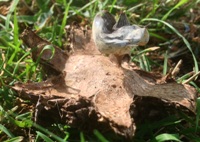 |
Ray structure
The outer peridium, which at maturity forms the base of the fruitbody, comprises six to nine irregular pointed rays up to 6cm across when fully expanded. The spore sac is joined to its base via a short stalk that has a distinct basal collar - this feature differentiates the Striated Earthstar from the slightly larger but otherwise very similar Beaked Earthstar Geastrum pectinatum. |
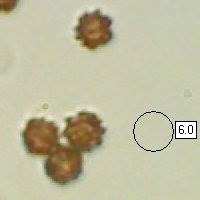 |
Spores
Globose, warty, 4-5μm diameter excluding the warts.
Spore mass
Dark brown. |
Odour/taste |
Not noticeable. |
Habitat |
Mainly found on dryish soils under conifers, particularly Leylandii in Britain, but sometimes also found with hardwood trees. |
Season |
Fruiting in the autumn; long lasting, and often visible all year round. |
Similar species |
Geastrum pectinatum has no collar below its spore sac. |
Culinary Notes
Earthstars are inedible and have no culinary value, but when dried they can make attractive table decorations as long as they do not get mistaken for pepper shakers!
Reference Sources
Fascinated by Fungi, 2nd Edition, Pat O'Reilly 2016, reprinted by Coch-y-bonddu Books in 2022.
Pegler, D.N., Laessoe, T. & Spooner, B.M (1995). British Puffballs, Earthstars and Stinkhorns. Royal Botanic Gardens, Kew.
Ellis J B, Ellis M B. (1990). Fungi without Gills (Hymenomycetes and Gasteromycetes): an Identification Handbook. London: Chapman and Hall. ISBN 0-412-36970-2.
BMS List of English Names for Fungi
Dictionary of the Fungi; Paul M. Kirk, Paul F. Cannon, David W. Minter and J. A. Stalpers; CABI, 2008
Taxonomic history and synonym information on these pages is drawn from many sources but in particular from the British Mycological Society's GB Checklist of Fungi.
Acknowledgements
This page includes pictures kindly contributed by Simon Harding and Wayne Hicks.
Top of page...
Fascinated by Fungi. Back by popular demand, Pat O'Reilly's best-selling 450-page hardback book is available now. The latest second edition was republished with a sparkling new cover design in September 2022 by Coch-y-Bonddu Books. Full details and copies are available from the publisher's online bookshop...